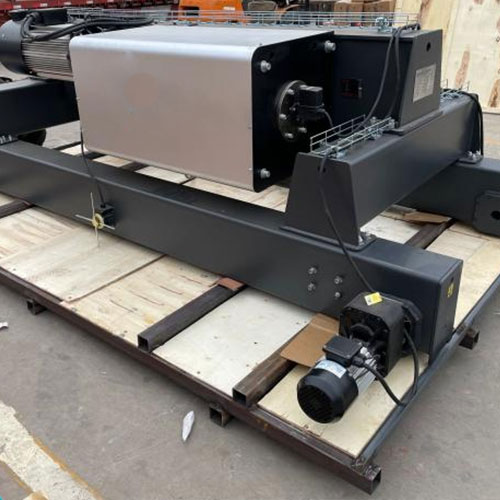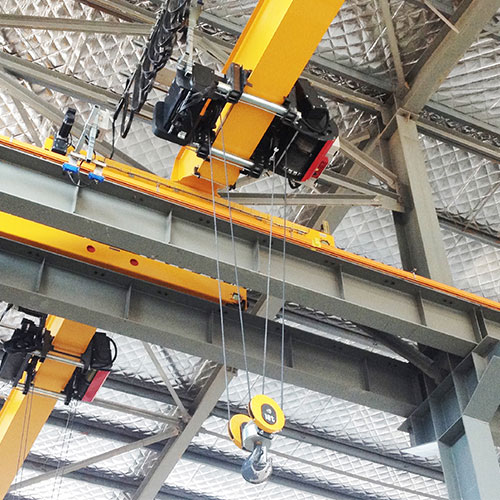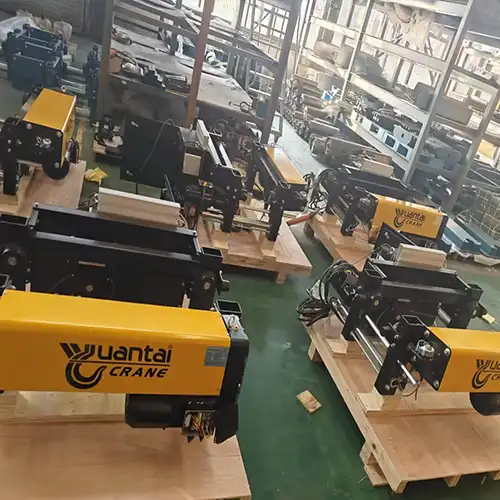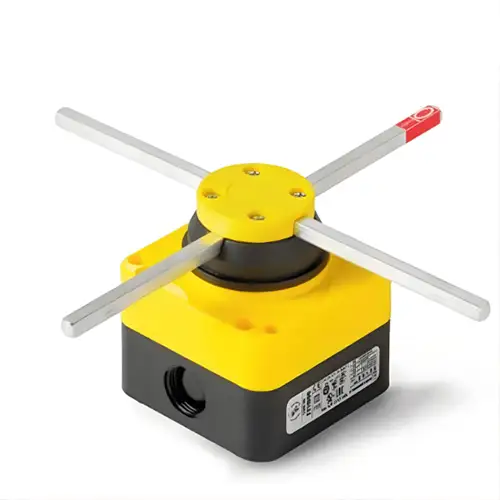Overhead Crane Safety Devices & Protection System Comprehensive Guide
A guide on overhead crane safety devices or protections should cover various safety features & mechanisms that help prevent accidents & ensure safe operation of overhead cranes.
Category: Featured
Your Trusted Overhead Crane Manufacturer & Supplier
Overhead Crane Safety Devices & Protection System Comprehensive Guide
A comprehensive guide on overhead crane safety devices or protections should cover various safety features and mechanisms that help prevent accidents and ensure the safe operation of overhead cranes. Below is an outline for such a guide:
Importance of Safety Devices in Overhead Crane Operation
Overhead cranes are powerful and essential tools in various industries, enabling the lifting and movement of heavy loads with precision and efficiency. However, due to their significant load-carrying capacity and potential hazards associated with their operation, ensuring the safety of both crane operators and those working in the vicinity is of paramount importance. Safety devices play a critical role in mitigating risks and preventing accidents, making them integral components of any overhead crane system.
By implementing appropriate safety devices, companies can:
- Minimize Accidents and Injuries: Safety devices act as crucial safeguards against potential accidents, reducing the likelihood of load drops, collisions, or other incidents that could cause injuries to personnel or damage to property.
- Enhance Operator Awareness: Safety devices provide crane operators with valuable real-time information, increasing their situational awareness and enabling them to make informed decisions during crane operations.
- Prevent Overloading: Overhead cranes have weight capacity limits, and exceeding these limits can lead to catastrophic consequences. Safety devices like overload protection systems help prevent overloading by alerting operators and automatically stopping the crane when the load exceeds the safe limit.
- Improve Productivity: While safety is the primary concern, the implementation of safety devices can also lead to increased productivity. By reducing downtime from accidents or equipment damage, the crane can operate more efficiently and effectively.
Overview of the Main Safety Categories
Safety devices for overhead cranes can be broadly categorized into the following groups:
- Limit Switches: Limit switches are electrical devices that monitor the position of various crane components, such as the hoist, bridge, and trolley. They are designed to prevent the crane from operating outside specific travel limits, ensuring safe operation within the designated working are
- Overload Protection: Overload protection systems monitor the load being lifted and prevent the crane from handling loads beyond its rated capacity. These systems use load cells or sensors to measure the load weight and provide visual or audible warnings to operators if the load approaches or exceeds the safe limit.
- Emergency Stop (E-Stop) System: E-Stop buttons are strategically located on the crane and the crane operator's pendant control. When activated, the E-Stop immediately halts all crane movements, allowing for swift response in emergency situations or when unsafe conditions are observed.
- Anti-Collision Devices: Anti-collision systems use various technologies, such as laser or RFID, to prevent collisions between multiple cranes or between a crane and other objects within its operating are These systems enhance safety and help avoid potential accidents caused by improper crane positioning.
- Crane Cameras and Visualization Systems: Camera systems installed on cranes provide operators with improved visibility, especially in blind spots. Visualization systems help crane operators navigate complex lifting operations more safely and accurately.
- Warning Lights and Audible Alarms: Warning lights and audible alarms are essential for signaling crane movements and alerts during critical operations. These visual and auditory cues help prevent accidents by notifying personnel of crane movements and potential hazards.
- Load Monitoring Systems: Load monitoring systems continuously measure the weight and distribution of the load being lifted, ensuring that it remains within safe limits. These systems provide real-time feedback to operators, preventing overloading and load imbalance.
- Electrical and Power Protections: Electrical safety devices, such as ground fault circuit interrupters (GFCIs) and phase loss protection, protect both personnel and equipment from electrical hazards and malfunctions.
By incorporating these safety categories into overhead crane design and operation, companies can significantly reduce the risk of accidents and create a safer work environment for their employees. Proper training, regular maintenance, and adherence to safety standards are essential to ensure the continued effectiveness of these safety devices over time.
Limit Switches
There are various types of limit switches employed in crane operations, each serving specific functions across different components of the crane's movement.
Firstly, the Hoist Travel Limit Switch is located on the hoisting mechanism of the crane. Its primary role involves restricting the vertical movement of the load. By preventing the hoist from reaching both the upper and lower ends of its path, this switch ensures that the hook avoids collisions with the overhead structure or contact with the ground.
Secondly, the Bridge Travel Limit Switch is positioned on the crane's bridge. It governs the lateral movement of the crane along the runway rails. This switch defines safe travel limits for the crane's lateral motion, preventing it from exceeding its designated operational are
Lastly, the Trolley Travel Limit Switch is mounted on the crane's trolley. It regulates the horizontal movement of the load along the bridge. This switch sets travel boundaries for the trolley's movement, preventing it from approaching too close to the bridge's ends, thus mitigating the risk of potential accidents.
Cross Limit Switch for Overhead Cranes

cross limit switch for overhead crane

safety limit swithch for crane cross travelling
- Enhanced with IP65 protection for increased durability against environmental elements.
- Incorporates advanced drive and control technology of superior quality.
- Implements obstacle avoidance mechanisms in both uni- and bidirectional travel.
- Facilitates swift transition between fast and slow modes while enforcing limits in both travel directions for optimized operational control.
The Cross Limit Switch is a rotary control mechanism equipped with a 300mm push rod featuring 3 to 5 valves. It operates within a rotation speed range of 12 to 200 rpm/minute and incorporates either 4 or 6 micro switches for precise functionality. This switch comes in two variants: one with a 90-degree rotation in both positive and negative directions, and another with a 180-degree rotation in the same directions.
Crafted from AgCdo material, the electric contact of this switch ensures substantial contact capacity and prolonged durability. Its structural components are constructed using flame-retardant PA66 engineering plastic, ensuring heightened safety. Designed to meet diverse requirements, this switch is well-suited for application in a multitude of settings, including crane operations, mining machinery, and other industrial fields.
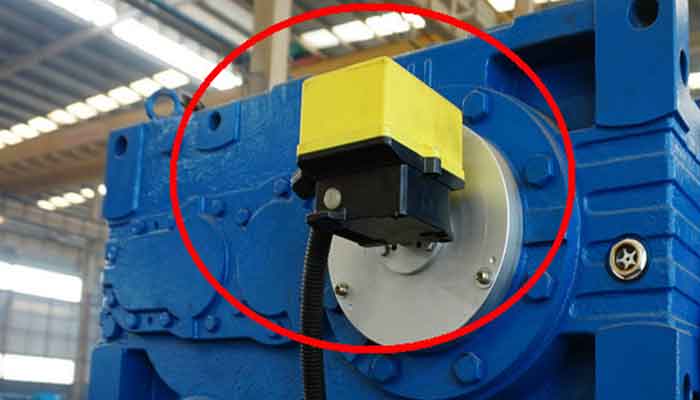
Universal Transfer Rotating Limit Switch
Technical Specifications:
- Operating Ambient Temperature: -25°C to +60°C
- Rated Voltage for Limit Switch: AC380V
- Rated Current for Limit Switch: AC380V, 10A
- Lifting Heights:
- QGX-A Type: 0 to 40 turns (0 to 25 turns) of effective work roll
- QGX-B Type: 0 to 80 revolutions (0 to 50 cycles)
- QGX-C Type: 0 to 120 turns (0 to 100 turns) of effective work roll
- Limit Switches: Equipped with four adjustable limit positions, configurable as normally open or normally closed as per requirements.
The height limiter functions by driving the rotation of the worm and worm gear through the spool shaft. Simultaneously, the cam positioned on the worm shaft undergoes rotation. As the cam reaches a specific position, its flange makes contact with the limit switch, causing the switch to activate. This action interrupts the power supply for either raising or lowering operations, thereby halting the spreader at the designated limit position. This product allows for the configuration of two safeguards for each ascent and descent, offering options like alarm and limit, or limit and protective limit.

Hammer Limit switch/ Gravity limit switch
Hook approached limit switch: Limit switch, chain,hitting block . Hook lifting will be stopped immediately while hook up to pre-set height . Option: 2-step hook approached limit switch(Slow-down and stop)
Electric hoist Gravity limit switch function: when the electric hoist rises to the limit position, the heavy hammer is triggered to cut off the coil voltage of the electric hoist lifting contactor.
The operational principle of both the heavy hammer limit and the regular limit functions similarly, achieving lifting and halting operations by disrupting the normally closed connection point. The heavy hammer limit finds predominant usage in double beam bridge cranes. This series operates within the control self-locking circuit to ensure effective control and operation.
Purpose and Function of Limit Switches
The primary purpose of limit switches in overhead crane systems is to enhance safety and prevent potentially dangerous situations during crane operation. Limit switches act as crucial control elements that enable the crane to operate within predefined boundaries. Here's how they function:
- Safety and Collision Prevention: Limit switches establish safe travel limits for the hoist, bridge, and trolley, ensuring that they do not exceed their designated paths. By preventing over-travel, these switches minimize the risk of collisions with the crane's structure, other cranes, or nearby objects, safeguarding both personnel and equipment.
- Preventing Overhead Hooking: The hoist travel limit switch is particularly essential for preventing the hook block from impacting the crane's steel structure at the upper end of its travel. By automatically stopping the hoist before reaching the maximum height, the switch prevents damage to the crane and the risk of catastrophic accidents.
- Preventing Bottom Hooking: Similarly, the hoist travel limit switch also prevents the hook from reaching the ground or any obstructions at the lower end of its travel. This feature avoids the risk of damage to the load, the hoist, and the floor, reducing potential hazards.
- Limiting Bridge and Trolley Motion: The bridge travel and trolley travel limit switches define the operational area of the crane within the runway rails. They prevent the crane from traveling too close to the edges, preventing accidental derailment or interference with other cranes on adjacent runways.
- Improved Precision and Performance: Limit switches ensure that the crane operates with precision and accuracy. By setting the limits for various crane movements, they help maintain smooth and controlled operations.
Testing and Maintenance Procedures
Regular testing and maintenance of limit switches are crucial to ensure their reliability and functionality. Here are some key procedures:
- Scheduled Inspections: Conduct routine inspections of the limit switches to check for signs of wear, damage, or misalignment. Include these inspections in the crane's maintenance plan to ensure they are performed regularly.
- Functional Testing: Regularly test the limit switches to verify their proper functioning. Follow the manufacturer's guidelines for conducting functional tests. Ensure that the switches accurately stop the crane's motion when reaching their respective travel limits.
- Calibration: If necessary, calibrate the limit switches to ensure they accurately correspond to the desired travel limits of the crane. Calibration may be needed if the crane undergoes significant modifications or repairs.
- Lubrication and Cleaning: Keep the limit switches clean and well-lubricated to prevent the accumulation of dirt or debris that could interfere with their operation.
- Repair and Replacement: If any limit switch is found to be faulty or malfunctioning during testing or inspection, promptly repair or replace it. Do not operate the crane until the issue is resolved.
- Operator Training: Train crane operators on the importance of limit switches and their proper use. Ensure operators understand the significance of following the travel limits and not attempting to override or bypass the switches.
- Documentation: Maintain detailed records of limit switch inspections, tests, and maintenance activities. This documentation helps track the condition of the switches over time and aids in compliance with safety regulations.
By diligently adhering to testing and maintenance procedures for limit switches, crane operators and maintenance personnel can ensure that these critical safety devices function effectively and contribute to a safer and more reliable overhead crane operation.
Overload Protection - Overload limit switch
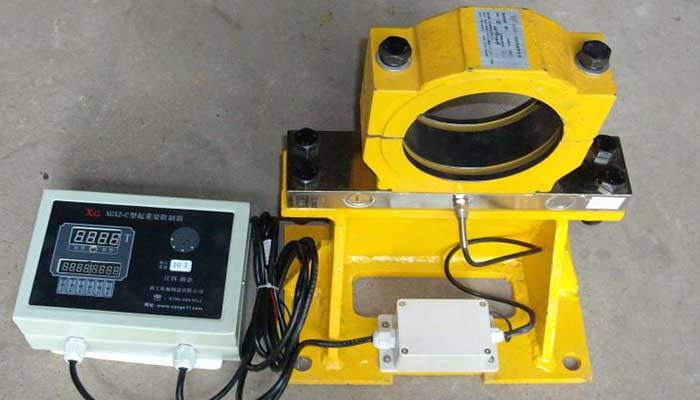
overload limit switch
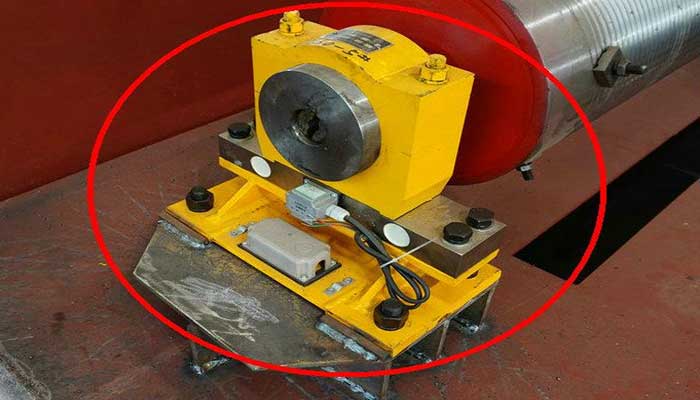
crane overload protection device
Feature Highlights:
- Real-time Monitoring: Equipped with a double-window 8-bit 0.8-inch high-brightness digital tube display, simultaneously showcasing the weight of the dual hooks for live monitoring. It efficiently captures and acquires the weight signals from two directions of lifting equipment.
- Acoustic-Optical Alert System: Upon reaching preset limit values during actual operations, the instrument triggers a sound and light alarm for immediate awareness. Additionally, it generates a safety control signal upon reaching these limits, ensuring construction safety.
- Anti-Interference Capability: Strong software and hardware components provide robust resistance against external electromagnetic interference.
- User-Friendly Interface: Full-key operation enables users to easily modify crane settings and working conditions.
- Jitter Delay Function: Anti-shake delay functionality significantly enhances the instrument's adaptability to input dat
- Power Interruption Protection: Ensures data integrity even during sudden power cuts, enabling continuous and reliable long-term operation.
- Voltage Adaptability: Supports both civil 220VAC and industrial 380VAC power inputs, offering strong on-site adaptability. Control loop outputs are compatible with both 220VAC and 380VA
- Wireless Sensor Compatibility: Capable of integrating wireless sensor devices for enhanced functionality.
- External Large Display: Facilitates real-time monitoring of lifting device load capacity for outdoor construction personnel through an external large, bright display screen.
- Enhanced Versatility: Meets diverse requirements across various crane machinery types and operating conditions for alarm functionalities. Ensures wider applicability with generic applicable devices and stable configuration software design, simplifying operating system choices.
- Faster, More Accurate, More Reliable: Utilizes a self-developed MS51 single-chip board as the motherboard core, paired with a standard I/O board and corresponding signal conditioning module for flexible data acquisition and output control. Enhances processing speed, precision, and overall reliability.
- Improved Scalability: The meter accommodates expansion with up to four relay controls and provides reserved slots for RS485 and 4~20mA enhancements.
Overload Indicators and Sensors
Overload protection is a critical safety feature in overhead crane systems that prevents the crane from lifting loads beyond its safe capacity. Overload indicators and sensors play a crucial role in detecting and alerting operators about potential overloading situations. Here's a closer look at these components:
- Load Cells: Load cells are precision instruments that measure the weight of the load being lifted. They are strategically positioned within the crane's lifting mechanism to provide real-time weight dat Load cells convert the load's force into an electrical signal, which is then processed by the crane's control system.
- Pressure Transducers: Commonly used in hydraulic systems, pressure transducers measure the hydraulic pressure generated by the load. This pressure corresponds to the load's weight and is translated into a load indication.
- Strain Gauges: Strain gauges are applied to crane components like hoist ropes or hooks. As the load causes stress on these components, the strain gauges detect the resulting strain changes. These changes are then converted into load measurements.
- Load Moment Indicators (LMIs): LMIs take into account both the weight of the load and the crane's boom length. By combining these factors, LMIs provide an accurate indication of the moment being exerted on the crane. They can issue warnings or alarms to operators when the load approaches the crane's safe working limits.
Overload Cut-off Mechanisms
Overload protection systems incorporate cut-off mechanisms to prevent crane operation when an overload is detected. These mechanisms halt crane movements to avoid lifting beyond the crane's rated capacity:
- Electronic Cut-off: Modern cranes often integrate overload protection into their control systems. When the load surpasses the safe limit, the system sends signals to immediately stop the crane's motion.
- Mechanical Limiters: Older crane models might employ mechanical devices that physically prevent further crane movement when an overload occurs.
- Hydraulic or Pneumatic Cut-offs: Hydraulic or pneumatic systems can trigger braking mechanisms or hydraulic locks, immediately stopping crane motion when overload conditions are detected.
Calculating and Setting Safe Load Limits
Determining safe load limits is a critical step in overhead crane safety. Several factors influence the calculation of safe load limits:
- Crane Specifications: Reference the crane's technical documentation, capacity charts, and manufacturer specifications to establish the maximum rated capacity.
- Load Distribution: Account for how the load's weight is distributed during lifting. Unevenly distributed loads can strain specific crane components.
- Angle of Lift: Adjust the crane's capacity calculation when lifting at angles other than vertical, as the angle affects the load's effective weight.
- Environmental Conditions: Consider external factors like wind, temperature, and ground conditions, as they can influence the crane's lifting capacity.
Importance of Load Testing
Load testing is a critical procedure for verifying the accuracy and reliability of overload protection systems. Load tests involve lifting loads that approach or slightly exceed the crane's rated capacity under controlled conditions. This process ensures that the overload protection mechanisms operate effectively and provides several key benefits:
- Safety Assurance: Load testing verifies that the crane's overload protection system responds appropriately, ensuring safe crane operation.
- Calibration Validation: Load testing helps identify any discrepancies between the overload protection system's readings and the actual load weight, enabling adjustments if necessary.
- Compliance with Standards: Regulatory standards often mandate periodic load testing to ensure crane safety and adherence to guidelines.
- Operator Confidence: Load testing gives crane operators and maintenance personnel confidence in the crane's ability to handle loads safely, minimizing accidents.
In conclusion, a robust overload protection system, with indicators, sensors, cut-off mechanisms, and load testing, is crucial for preventing crane overloading and ensuring safe operations. Regular maintenance, compliance with load limits, and proper operator training are all essential components of effective overload protection strategies.
Emergency Stop (E-Stop) System -Emergency Power Cut-off Switch
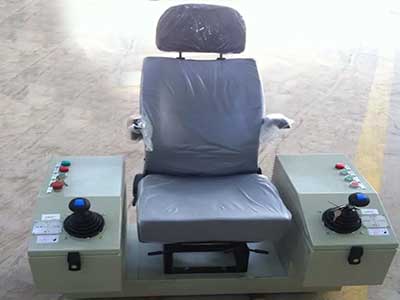
Cabin control with emergy stop button

Remote control with emergy stop button
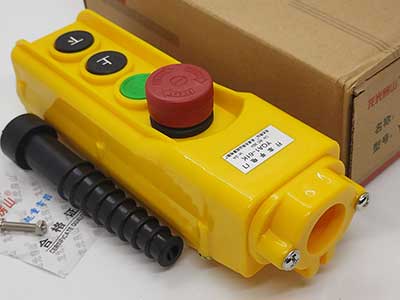
Pendant control with emergy stop button
A crane must be equipped with an emergency power cut-off switch that can quickly disconnect the main power supply in urgent situations. This switch should be conveniently located for the operator. The emergency power cut-off should not have an automatic reset feature."
Purpose and Location of Emergency Stop Buttons
Emergency Stop (E-Stop) buttons are critical safety devices installed on overhead cranes to immediately halt all crane movements in case of an emergency or when unsafe conditions are observed. Their purpose is to prevent accidents, protect personnel, and minimize potential damage to equipment. Proper placement of E-Stop buttons is essential for quick and easy access. Key considerations include:
- Strategic Placement: E-Stop buttons should be easily reachable and located at various points on the crane, including the operator's pendant control, control panels, and near entrances/exits to the crane's operating are
- Clear Labeling: E-Stop buttons must be clearly labeled with recognizable symbols or text indicating their purpose to ensure they are easily identifiable during high-stress situations.
- Accessibility: The location of E-Stop buttons should not obstruct the operator's movement or crane operation, but they should be readily accessible without requiring excessive effort.
Activation and Reset Procedures
- Activation: In case of an emergency or hazardous situation, crane operators or any personnel in the vicinity can activate the E-Stop button by pressing it. When activated, the E-Stop system should immediately cut power to the crane's drive motors, stopping all crane movements.
- Immediate Effect: The E-Stop system's design ensures that crane operations come to a complete halt as soon as the button is pressed, regardless of the crane's current state.
- Lock-In Feature: Once an E-Stop button is activated, it often requires a manual reset or release action to reactivate the crane. This prevents accidental restarts and ensures that a thorough inspection is performed before resuming operations.
Testing and Maintenance Requirements
To ensure the reliability and effectiveness of the E-Stop system, regular testing and maintenance are crucial:
- Scheduled Testing: Conduct routine testing of the E-Stop buttons to verify that they function correctly. This can involve simulated activations to ensure that the system responds promptly and halts all crane movements.
- Comprehensive Inspection: Inspect the physical condition of E-Stop buttons regularly. Ensure that buttons are not damaged, stuck, or worn out, as these issues can compromise their functionality.
- Reset Functionality: Verify that the E-Stop reset procedure works as intended. After pressing the button and stopping crane operations, ensure that the system can be safely reset without any residual hazards.
- Operator Training: Train crane operators on the proper use of E-Stop buttons, including their location and activation methods. Emphasize the importance of using E-Stops only in emergencies or unsafe situations.
- Documentation: Keep detailed records of E-Stop testing and maintenance activities. This documentation helps track the system's performance and compliance with safety regulations.
- Immediate Repairs: If any E-Stop button is found to be malfunctioning during testing or inspection, repair or replace it promptly. Do not operate the crane until the issue is resolved.
- Regular Review: Periodically review the effectiveness of the E-Stop system as part of crane safety audits. Incorporate feedback from crane operators to identify potential improvements.
An effective E-Stop system ensures the safety of crane operators and personnel working in the vicinity. Regular testing and proper maintenance of the E-Stop buttons contribute to the overall safety and reliability of the overhead crane system.
Anti-Collision Devices for Crane Long Travelling - Infrared anti-collision instrument
Anti-collision devices are crucial safety mechanisms in overhead crane systems that prevent collisions between cranes or between cranes and other objects within the crane's operating are They play a significant role in enhancing safety, minimizing downtime, and preventing costly accidents. Two common types of anti-collision devices are laser-based collision avoidance systems and RFID-based systems for crane positioning.
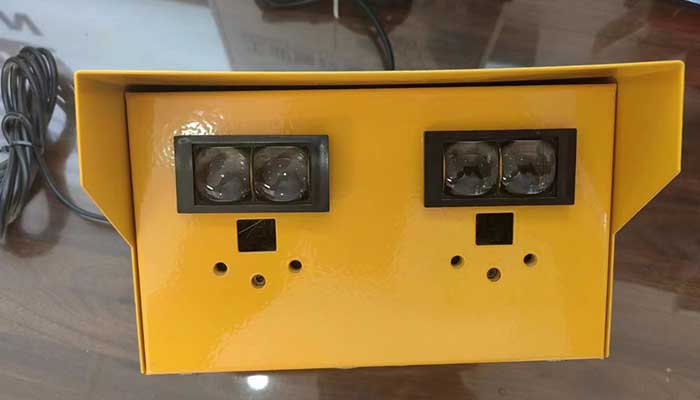
Operating Principle:
This device operates on dual power supplies, utilizing +5V and +12V for its functionalities. It leverages laser reflection principles in the air to detect obstacles. The system integrates laser transmit/receive modules as interface components, employing microcontroller technology to compute distances based on the laser beams in the air. By processing the time taken for the laser wave to travel through the medium (with the speed of the laser wave equivalent to the speed of sound), it calculates the corresponding distance. Subsequently, this measured distance is compared against the preset braking distance. Upon reaching the specified threshold, the device promptly engages the brakes, preventing collisions between vehicles.
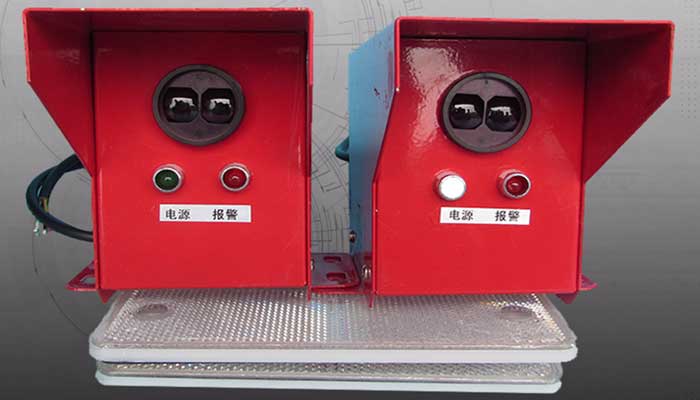
Application:
This product boasts high integration, intelligence, and adaptability. The intelligent processor it features is well-suited for automating distance measurement and implementing limit braking in various lifting equipment scenarios, including different crane types, overhead cranes, track electric flat cars, and more.
Laser-Based Collision Avoidance Systems
Laser-based collision avoidance systems use laser sensors to create a detection zone around the crane. When an object enters this zone, the sensors detect the intrusion and send signals to the crane's control system. Here's how they work:
- Sensor Setup: Laser sensors are installed at strategic points on the crane, such as the front, sides, and rear. These sensors emit laser beams that scan the crane's surroundings.
- Detection Zone: The laser beams define a virtual detection zone around the crane. If any object enters this zone, the sensors detect the presence of the object.
- Warning and Intervention: When an object is detected within the detection zone, the collision avoidance system sends signals to the crane's control system. Depending on the system's configuration, the crane operator may receive visual or audible warnings, and in some cases, the system might initiate automatic deceleration or stop the crane's movement to prevent a collision.
RFID-Based Systems for Crane Positioning
RFID-based systems use Radio Frequency Identification (RFID) technology to accurately track the position of cranes and other equipment within a facility. These systems provide real-time data about crane locations, ensuring safe distances are maintained:
- Tagging Crane Components: Each crane, along with other objects in the crane's operating area, is equipped with RFID tags. These tags emit radio signals that can be detected by RFID readers.
- Position Tracking: RFID readers are positioned strategically around the facility. As cranes and objects move, the readers receive signals from the RFID tags, allowing the system to continuously track their positions.
- Real-Time Monitoring: The RFID-based system collects and processes data from the RFID tags and readers, creating a real-time map of crane positions. This data is relayed to the control room or operator interface.
- Alerts and Intervention: If two cranes approach each other within an unsafe distance, the system can issue alerts to crane operators or automatically intervene by slowing down or stopping one or both cranes to prevent a collision.
Benefits of Anti-Collision Devices:
- Enhanced Safety: Anti-collision devices significantly reduce the risk of collisions, protecting both crane operators and equipment.
- Downtime Reduction: By preventing collisions, anti-collision devices minimize downtime caused by accidents, repairs, and operational disruptions.
- Increased Productivity: With reduced downtime and improved safety, cranes can operate more efficiently, contributing to higher productivity.
- Situational Awareness: Anti-collision systems provide crane operators with better visibility and information about their surroundings, enabling them to make more informed decisions.
- Flexibility: These systems are adaptable to various crane configurations, making them suitable for a wide range of industrial settings.
Limitations of Anti-Collision Devices:
- False Positives: External factors like reflections, weather conditions, or obstructions can lead to false collision alerts, potentially impacting crane operations.
- System Complexity: Implementing and maintaining anti-collision systems may require specialized expertise and ongoing maintenance.
- Technology Limitations: While highly effective, no system is foolproof, and unexpected circumstances or system failures could still lead to collisions.
- Initial Investment: There's an initial cost associated with installing and integrating anti-collision devices into the crane system.
In conclusion, anti-collision devices, whether laser-based or RFID-based, are essential for preventing collisions and enhancing safety in overhead crane operations. Understanding their benefits and limitations is crucial for selecting the right anti-collision system for a specific industrial setting and ensuring optimal crane safety.
Collision Avoidance Systems
Collision avoidance systems are vital safety features in overhead crane operations that prevent collisions between cranes, objects, and personnel within the crane's working environment. These systems enhance safety by providing real-time detection and warning mechanisms to crane operators and control systems. Here's an overview of proximity sensors for obstacle detection, zone control systems for restricted areas, and the integration of collision avoidance systems with crane controls for automatic response:
Proximity Sensors for Obstacle Detection
- Function: Proximity sensors use various technologies (such as ultrasonic, infrared, or radar) to detect nearby objects within the crane's operating are When an object is detected, the sensor sends signals to the control system, initiating appropriate warnings or actions.
- Detection Range: Proximity sensors are strategically positioned on the crane's critical points, such as the front, sides, and rear. The detection range can be adjusted based on the crane's movements and potential collision points.
- Warnings: When an obstacle is detected, proximity sensors can trigger visual and audible warnings in the crane's operator ca This alerts the crane operator to take immediate action to avoid a collision.
Zone Control Systems for Restricted Areas
- Zone Configuration: Zone control systems divide the crane's operating area into zones, each with its unique safety requirements. Some areas might require crane operators to slow down, while others could necessitate a complete stop.
- Sensors and Control Logic: Zone control systems utilize sensors and control logic to determine the crane's position and proximity to each zone. When the crane enters a restricted zone, the system triggers appropriate warnings or actions.
- Progressive Warnings: Zone control systems can provide progressive warnings as the crane approaches a restricted zone, allowing operators time to react and slow down before reaching the critical are
Integration with Crane Controls for Automatic Response
- Real-Time Communication: Collision avoidance systems are integrated with the crane's control system. When sensors detect an obstacle or the crane enters a restricted zone, they communicate with the control system in real time.
- Automatic Responses: Depending on the configuration, collision avoidance systems can initiate automatic responses. These responses may include slowing down the crane, stopping it entirely, or adjusting crane movements to avoid collisions.
- Operator Input: In some cases, the collision avoidance system might provide the crane operator with warnings or suggestions for action. The operator can then use this information to make informed decisions.
- Emergency Response: In critical situations, collision avoidance systems can trigger immediate emergency stops to prevent an imminent collision.
Implementing collision avoidance systems not only prevents accidents but also enhances overall crane operations by reducing downtime and increasing efficiency. Regular maintenance, testing, and operator training are essential for ensuring that these systems function effectively and contribute to a safer work environment.

spring type crane buffer
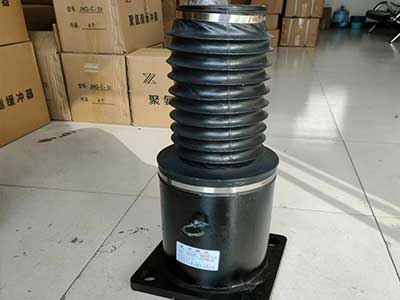
hydraulic crane buffer
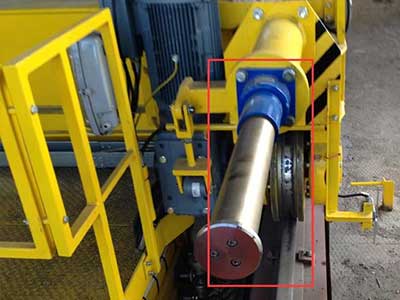
anti-collision crane buffer
Crane Cameras and Visualization Systems
Crane cameras and visualization systems are advanced technologies that provide enhanced visibility and situational awareness during overhead crane operations. They play a critical role in improving safety, operational efficiency, and precision. Here's an overview of their use, installation, positioning, and integration with monitoring and control systems:
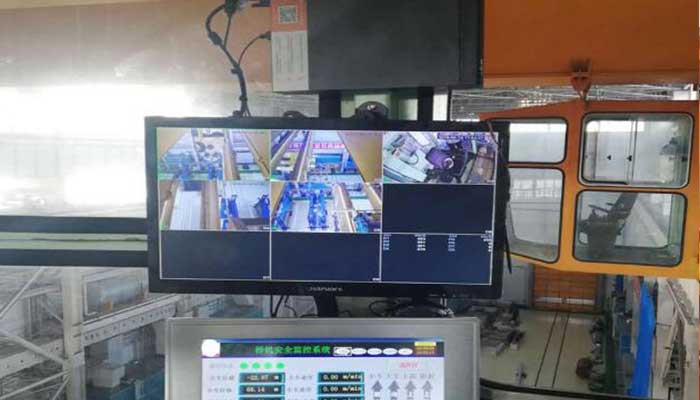
overhead crane visualizing system - camor monitoring system

Crane visulizing
Use of Cameras for Improved Visibility
Crane cameras offer crane operators and personnel a clearer view of the crane's operating environment, reducing blind spots and improving overall awareness. They are particularly beneficial for:
- Obstacle Detection: Cameras help operators identify obstacles, personnel, or equipment within the crane's operating area, preventing potential collisions.
- Load Monitoring: Cameras enable operators to monitor the load and its positioning, ensuring accurate placement and minimizing the risk of accidents.
- Complex Lifts: During complex lifts, cameras provide operators with real-time visuals that aid in precise load positioning.
- Weather Conditions: In adverse weather conditions, such as rain or fog, cameras provide enhanced visibility that would otherwise be compromised.
Installing and Positioning Crane Cameras
Proper installation and positioning of crane cameras are crucial to achieving their intended benefits:
- Strategic Placement: Cameras should be strategically positioned to cover blind spots and critical areas around the crane, such as load pick-up points, hook areas, and the crane's path of movement.
- Durability: Choose cameras that are rugged and designed to withstand the environmental conditions of the crane's operating environment, including temperature variations, dust, and vibrations.
- Optimal Viewing Angle: Adjust the camera's angle to provide the best possible view of the crane's surroundings. Consider using cameras with adjustable mounts for flexible positioning.
- Multiple Cameras: Depending on the crane's configuration, multiple cameras can be installed to cover various angles and areas of concern.
Integration with Monitoring and Control Systems
Integration of crane cameras with monitoring and control systems enhances their functionality and utility:
- Video Display: Cameras are connected to display screens within the crane's operator cab, giving operators real-time visual feedback.
- Remote Monitoring: In addition to operator displays, camera feeds can be routed to central control rooms for remote monitoring by supervisors or safety personnel.
- Overlay Information: Some advanced systems can overlay additional information on the camera feed, such as load weight, crane position, or proximity warnings.
- Recording and Playback: Cameras can record crane operations, providing valuable data for analysis, incident investigations, and operator training.
- Integration with Alarms: Camera systems can be integrated with audible or visual alarms to notify operators of potential hazards detected by the cameras.
- Data Logging: Camera systems can log data related to crane operations and camera feeds, which can be useful for compliance reporting and continuous improvement.
By integrating crane cameras and visualization systems into overhead crane operations, companies can enhance safety, reduce the risk of accidents, and improve operational efficiency. Regular maintenance of cameras and related systems, along with operator training on their use, is essential to ensuring their continued effectiveness.
Warning Lights and Audible Alarms
Warning lights and audible alarms are crucial components of overhead crane safety systems. They provide visual and auditory signals to alert personnel in the vicinity of the crane, enhancing safety awareness and preventing accidents. Here's an overview of different types of warning lights, audible alarms, and the importance of complying with signaling standards:
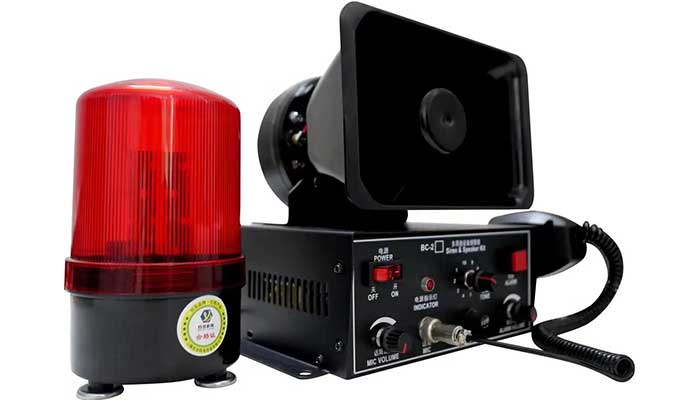
Audiovisual Alarm
- A loud single-tone alarm sounds when the crane starts moving.
- Capability for the operator to manually signal.
- Capability for the operator to manually flash lights."
Types of Warning Lights
- Strobe Lights: Strobe lights emit high-intensity flashes of light, making them highly visible even in challenging lighting conditions. They are effective at attracting attention and indicating active crane movements.
- LED Lights: LED lights are energy-efficient and long-lasting, making them a popular choice for warning lights. They come in various colors and can be configured to flash or remain steady.
- Rotating Beacons: Rotating beacons emit a rotating beam of light, creating a distinctive visual signal that is easily recognizable from a distance.
- Flashing Lights: Flashing lights, whether incandescent or LED, provide attention-grabbing signals that highlight crane activity or potential hazards.
- Color Coding: Different colors can be used to indicate different crane states or actions. For example, a red light might indicate crane movement, while a green light might indicate safe conditions.
Audible Alarms for Crane Movements
Audible alarms work in conjunction with warning lights to provide auditory cues that complement the visual signals. Different audible alarms can signify different crane movements or actions:
- Back-Up Alarms: These alarms sound when the crane is moving in reverse, warning personnel in the crane's path.
- Horn Alarms: Horn alarms can be activated before the crane begins moving or during specific crane maneuvers to alert personnel to imminent motion.
- Proximity Alarms: Audible alarms can sound when the crane approaches a designated safety zone, warning personnel to keep a safe distance.
- Collision Alarms: Some systems use audible alarms to warn crane operators and nearby personnel if a potential collision is detected by anti-collision devices.
Compliance with Signaling Standards
Compliance with signaling standards ensures consistency, effectiveness, and proper communication of crane movements and potential hazards:
- OSHA Regulations: The Occupational Safety and Health Administration (OSHA) sets guidelines for crane safety, including requirements for warning lights and audible alarms to prevent accidents.
- Industry Standards: Different industries may have specific standards for signaling devices based on the unique challenges of their operating environments.
- Visibility and Audibility: Signaling devices must be placed where they can be easily seen and heard by crane operators and personnel. They should be tested to ensure they are visible and audible over the surrounding noise.
- Consistency: Standardized signals help ensure that crane operators and personnel understand the meaning of different signals, enhancing overall safety.
Incorporating effective warning lights and audible alarms in overhead crane operations is essential to alerting personnel to crane movements and potential hazards. Proper selection, installation, and compliance with signaling standards contribute to a safer work environment and minimize the risk of accidents.
Load Monitoring Systems
Load monitoring systems are essential safety features in overhead crane operations that continuously measure and monitor the weight and distribution of the load being lifted. These systems play a crucial role in preventing overloading and ensuring safe crane operations. Here's an overview of load cells, load sensing devices, monitoring load weight and distribution, as well as alarms and cut-off mechanisms for excessive loads:
Load Cells and Load Sensing Devices
- Load Cells: Load cells are precision instruments that directly measure the weight of the load. They are installed within the crane's lifting mechanism and convert the load's force into an electrical signal. Load cells are known for their accuracy and reliability in providing real-time weight measurements.
- Pressure Transducers: Pressure transducers are commonly used in hydraulic systems. They measure the hydraulic pressure generated by the load and translate it into load weight. These devices are suitable for hydraulic-powered overhead cranes.
- Strain Gauges: Strain gauges are applied to critical crane components, such as hoist ropes or hooks. As the load puts stress on these components, strain gauges detect the resulting strain changes and calculate the load weight.
Monitoring Load Weight and Distribution
- Real-Time Data: Load monitoring systems provide real-time data on the weight of the load being lifted. This information helps crane operators make informed decisions about load handling and positioning.
- Load Distribution: In addition to weight, load monitoring systems can also assess the distribution of weight across the crane's lifting points. Uneven weight distribution can strain crane components and lead to instability.
- Angle of Lift: Some load monitoring systems consider the angle at which the load is lifted, adjusting the load weight calculation based on the angle. This ensures accurate weight measurements even when lifting at angles other than vertical.
Alarms and Cut-Off Mechanisms for Excessive Loads
- Visual and Audible Alarms: Load monitoring systems can be integrated with warning lights and audible alarms. If the load approaches or exceeds the crane's safe load limit, visual and audible alerts are triggered to notify crane operators and personnel.
- Cut-Off Mechanisms: Load monitoring systems can also include cut-off mechanisms that prevent crane movements when the load exceeds safe limits. These mechanisms can automatically stop the crane's motion to prevent overloading.
- Operator Warnings: In some cases, the load monitoring system may provide warnings to the crane operator, giving them a chance to adjust the load or take corrective actions before any automatic cut-off is activated.
- Safe Load Indicators: Load monitoring systems can be linked to Safe Load Indicators (SLIs) or Load Moment Indicators (LMIs), which provide visual or audible feedback to crane operators about the load's weight and its impact on the crane's stability.
Load monitoring systems are crucial for preventing overloading, which can lead to accidents, equipment damage, and compromised crane stability. Integrating these systems with visual and audible alarms, as well as cut-off mechanisms, enhances overall safety and ensures that crane operations remain within safe load limits.
Electrical and Power Protections
Ensuring the electrical and power integrity of overhead crane systems is paramount for safe and reliable operations. Electrical and power protections play a critical role in preventing electrical hazards, equipment damage, and operational disruptions. Here's an overview of ground fault circuit interrupters (GFCIs), phase loss and phase sequence protection, as well as voltage and current monitoring devices:
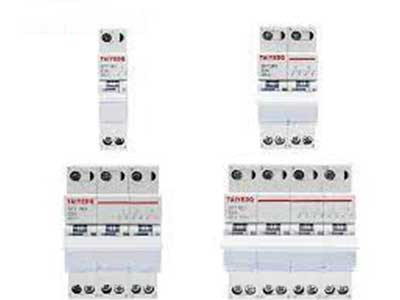
Main Power Supply Isolation Switch
Always turn off power before working on electrical equipment. Install an isolation switch between the equipment and the power supply for safety. Ensure the switch visibly disconnects power, allowing easy confirmation for maintenance personnel.

Short-Circuit Protection for Main Power Supply
When there's insulation damage or phase-to-phase short circuits in electrical equipment on a crane, the short-circuit protection device for the main power supply must swiftly act to cut off the faulty power source. This protection mechanism for the main power supply should be implemented using fuses or circuit breakers.
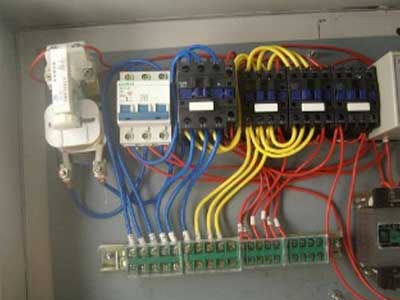
Motor Overload Protection
Motors exceeding 1KW in rated power on cranes should have a dedicated overload protection system. Overcurrent protection is the prevalent method used for motor overload protection on cranes.
Ground Fault Circuit Interrupters (GFCIs)
- Function: GFCIs are safety devices that monitor the flow of electrical current. They are designed to quickly detect imbalances in the current between the hot and neutral wires. If a ground fault occurs, where current is leaking to the ground due to a fault in the circuit, the GFCI trips and cuts off power to the circuit.
- Protection: GFCIs prevent electrical shocks by swiftly interrupting the current when they detect a ground fault. This is especially crucial in crane operations, where moisture, damp environments, and proximity to the ground can increase the risk of electrical faults.
- Location: GFCIs should be installed at appropriate locations within the electrical circuit, such as the power supply, control panels, and any electrical outlets near the crane's operating are
Phase Loss and Phase Sequence Protection
- Phase Loss Protection: Phase loss protection monitors the supply voltage to the crane's electrical components. If one or more phases are lost or drop below a safe threshold, the protection system activates, preventing the crane from operating with inadequate power.
- Phase Sequence Protection: This protection ensures that the phases of the supply voltage are in the correct sequence. Incorrect phase sequencing can lead to unbalanced loads and potential motor damage. The protection system detects and rectifies phase sequence anomalies.
Voltage and Current Monitoring Devices
- Voltage Monitoring: Voltage monitoring devices continuously monitor the supply voltage to the crane. If the voltage deviates from the acceptable range, the system can trigger alarms, warnings, or even cut off power to prevent unsafe operations.
- Current Monitoring: Current monitoring devices track the current drawn by the crane's motors and components. Abnormal current levels can indicate motor overloads, short circuits, or other electrical issues. The protection system responds by initiating alarms or protective actions.
- Integration with Control Systems: Voltage and current monitoring devices can be integrated with the crane's control system. If abnormal conditions are detected, the control system can take corrective actions or alert the crane operator.
Electrical and power protections are essential to maintaining a safe and functional overhead crane system. By incorporating GFCIs, phase loss and phase sequence protection, and voltage and current monitoring devices, companies can mitigate the risk of electrical hazards, equipment damage, and disruptions to crane operations. Regular maintenance and testing of these protection systems are critical to their effectiveness and overall crane safety.
Crane Sway Control
Crane sway control is essential for minimizing the swinging motion of loads during lifting, positioning, and transporting operations. Sway control mechanisms aim to improve safety, accuracy, and efficiency in overhead crane operations. Here's an overview of sway control mechanisms, active and passive sway control methods, and techniques for reducing load swing during crane movements:
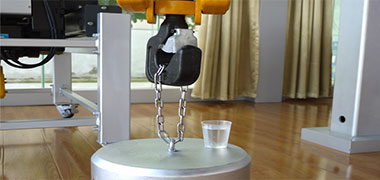
Sway Control Mechanisms
- Damping Mechanisms: Damping mechanisms, such as shock absorbers or hydraulic dampers, are installed in the crane's lifting mechanism. They absorb and dissipate kinetic energy, reducing the oscillation of the load.
- Anti-Sway Devices: Anti-sway devices use sensors and control algorithms to detect load sway and counteract it by adjusting the crane's motions. These devices can be retrofitted onto existing cranes.
- Variable Frequency Drives (VFDs): VFDs can be used to control the speed and acceleration of the crane's motors, allowing for smoother and more controlled movements that minimize load swing.
Active and Passive Sway Control Methods
- Active Sway Control: Active sway control methods involve real-time monitoring of load sway and active adjustments of the crane's movements to counteract it. These methods typically utilize sensors, algorithms, and advanced control systems.
- Passive Sway Control: Passive sway control mechanisms, such as damping systems, reduce sway by dissipating energy without direct intervention by the crane operator or control system.
Reducing Load Swing During Crane Movements
- Smooth Acceleration and Deceleration: Sudden starts and stops can induce load swing. Gradual acceleration and deceleration help reduce the oscillation of the load.
- Synchronized Movements: Coordinating the motions of the crane's trolley and hoist helps minimize load sway. Modern cranes with integrated control systems can automate this synchronization.
- Tag Lines: Tag lines are ropes or lines attached to the load to provide manual control and damping of load sway during lifting and positioning.
- Use of Pendulum Effect: In some cases, controlled pendulum movements can be used to counteract load swing. By moving the load slightly in the opposite direction of the swing, operators can dampen the oscillation.
- Operator Training: Proper training for crane operators is essential. Skilled operators can anticipate load movements and make adjustments to minimize sway.
- Advanced Control Systems: Cranes equipped with advanced control systems, such as computerized anti-sway systems, can automatically counteract load sway and ensure precise load positioning.
Sway control is critical for safe and efficient overhead crane operations, especially when dealing with heavy or delicate loads. Utilizing a combination of damping mechanisms, anti-sway devices, and operator techniques can significantly reduce load swing, enhance operational efficiency, and prevent accidents.
Maintenance and Inspection of Safety Devices
Maintaining and inspecting safety devices is essential to ensure the continued effectiveness of safety measures in overhead crane operations. Regular assessments, testing, and timely repairs or replacements are crucial for a safe and reliable working environment. Here's an overview of establishing a regular inspection schedule, testing procedures, documentation, and the importance of prompt repairs and replacements:
Regular Inspection Schedule for Safety Devices
- Frequency: Safety devices, including limit switches, overload protection systems, collision avoidance systems, and more, should be inspected regularly. The frequency of inspections depends on factors such as the intensity of crane use, environmental conditions, and manufacturer recommendations.
- Scheduled Intervals: Establish a predetermined inspection schedule based on industry standards, regulatory requirements, and the manufacturer's recommendations. Daily, weekly, monthly, and annual inspections may be appropriate for different devices.
Testing Procedures and Documentation
- Visual Inspection: Start with a visual inspection of safety devices to check for any signs of wear, damage, corrosion, or abnormal conditions.
- Functional Testing: Perform functional tests to ensure that safety devices operate as intended. Test limit switches, overload protection systems, collision avoidance sensors, and other safety features according to manufacturer guidelines.
- Load Testing: Periodically perform load testing to verify the accuracy and responsiveness of overload protection systems and load monitoring devices.
- Documentation: Maintain thorough records of inspection dates, findings, test results, and any corrective actions taken. This documentation is crucial for tracking the performance of safety devices over time and demonstrating compliance with safety regulations.
Importance of Timely Repairs and Replacements
- Prompt Repairs: If any safety device is found to be malfunctioning, damaged, or not operating correctly, it should be repaired promptly by qualified personnel. Operating a crane with faulty safety devices can lead to accidents and equipment damage.
- Replacement: Safety devices have a finite lifespan, and wear and tear can affect their performance over time. Replace safety devices that are beyond their recommended service life to ensure consistent and reliable safety measures.
- Avoiding Downtime: Timely repairs and replacements contribute to minimizing downtime due to unexpected failures or accidents, which can result in costly disruptions to operations.
- Legal Compliance: Adhering to inspection schedules and promptly addressing issues with safety devices is essential for compliance with safety regulations and standards.
- Operator Confidence: A well-maintained and properly functioning safety system instills confidence in crane operators and contributes to a safer work environment.
Regular maintenance, thorough inspections, and prompt repairs or replacements of safety devices are critical components of an effective safety management program for overhead crane operations. Prioritizing safety and investing in proper maintenance practices contribute to accident prevention, operational efficiency, and a productive workplace.
Operator Training and Awareness
Operator training and awareness are fundamental aspects of maintaining a safe overhead crane operation. Proper training on safety device operation, promoting operator vigilance, and establishing a culture of reporting and addressing safety device malfunctions are crucial for preventing accidents and ensuring a secure working environment. Here's an overview of these key elements:
Training on Safety Device Operation and Function
- Comprehensive Training: Provide crane operators with comprehensive training on the operation, function, and significance of various safety devices, including limit switches, anti-collision systems, load monitoring systems, and more.
- Device Familiarization: Ensure that operators are familiar with the location and operation of safety devices within the crane's control panel and operator ca
- Emergency Procedures: Train operators on emergency procedures related to safety device activation, such as emergency stops, alarms, and cut-off mechanisms.
- Refresher Training: Offer periodic refresher training sessions to reinforce knowledge and update operators on any new safety technologies or procedures.
Encouraging Operator Vigilance and Attentiveness
- Safety Culture: Foster a culture of safety consciousness among crane operators and all personnel working in the crane's vicinity. Emphasize that safety is everyone's responsibility.
- Pre-Shift Inspections: Encourage operators to perform pre-shift inspections to ensure that all safety devices are in proper working condition before starting operations.
- Situational Awareness: Train operators to maintain situational awareness, staying attentive to their surroundings and anticipating potential hazards.
- Load Monitoring: Educate operators on the significance of load monitoring, sway control, and collision avoidance systems in preventing accidents and ensuring accurate load positioning.
Reporting and Addressing Safety Device Malfunctions
- Reporting Procedures: Establish clear procedures for operators to report any malfunctions, anomalies, or issues related to safety devices. Create an environment where reporting is encouraged and valued.
- Timely Reporting: Stress the importance of timely reporting of safety device malfunctions to prevent accidents and disruptions to operations.
- Response Mechanism: Develop a well-defined response mechanism for addressing reported malfunctions promptly. Ensure that qualified maintenance personnel are available to address issues.
- Documentation: Document all reported safety device malfunctions, actions taken to address them, and the resolution outcomes. Use this documentation for analysis and continuous improvement.
- Operator Feedback: Encourage operators to provide feedback on safety devices based on their operational experiences. This feedback can lead to system improvements and better training.
Operator training, awareness, and engagement are critical components of a comprehensive safety strategy for overhead crane operations. By ensuring that operators are well-trained, vigilant, and proactive in reporting safety concerns, organizations can create a safer work environment and prevent accidents associated with crane operations.
Regulatory Compliance and Standards
Maintaining regulatory compliance and adhering to industry standards are essential for ensuring the safety and legality of overhead crane operations. Comprehensive knowledge of regulations, conducting compliance audits and inspections, and going beyond minimum requirements by incorporating best practices are vital for creating a safe working environment. Here's an overview of these key aspects:
OSHA and Industry-Specific Regulations
- OSHA Regulations: Understand and comply with relevant Occupational Safety and Health Administration (OSHA) regulations that pertain to overhead crane operations. OSHA provides guidelines and standards for crane safety, operator training, inspections, and more.
- Industry-Specific Standards: Different industries may have specific standards related to crane safety due to their unique operating environments and risks. Research and adhere to these industry-specific standards.
- Regulatory Updates: Stay informed about updates or changes to regulations and standards that may affect overhead crane operations. Regularly review official sources and industry associations for the latest information.
Compliance Audits and Inspections
- Regular Audits: Conduct regular compliance audits of your overhead crane operations to assess whether all safety devices, training, procedures, and documentation meet regulatory requirements and industry standards.
- Internal Inspections: Establish a systematic internal inspection process that covers all aspects of crane safety, from equipment to operator behavior. Assign responsible personnel to conduct and document these inspections.
- Third-Party Inspections: Consider involving third-party inspectors to conduct independent evaluations of your crane safety practices. Their unbiased assessments can provide valuable insights.
Incorporating Best Practices Beyond Regulatory Requirements
- Continuous Improvement: Strive to exceed minimum regulatory requirements by adopting industry best practices for crane safety. Continuously seek out opportunities to enhance safety measures.
- Industry Guidelines: Utilize safety guidelines and recommendations from respected industry organizations to supplement regulatory compliance. These organizations often provide comprehensive resources for crane safety.
- Safety Committees: Establish safety committees that include representatives from various departments to collaborate on identifying and implementing best practices for crane safety.
- Operator Feedback: Encourage crane operators and personnel to provide feedback on safety procedures and equipment. Incorporate their insights into refining safety practices.
- Training and Education: Provide ongoing training and education to keep all stakeholders, including crane operators, maintenance personnel, and supervisors, informed about the latest safety practices.
Maintaining regulatory compliance and adhering to industry standards are essential foundations of overhead crane safety. By conducting audits, inspections, and incorporating best practices, organizations can create a safer and more productive work environment while demonstrating a commitment to employee well-being and legal obligations.
Wrap it Up,
Creating a safe and secure environment for overhead crane operations is a multifaceted endeavor that involves a combination of safety devices, operator training, regulatory compliance, and a strong safety culture. As we conclude this comprehensive guide on overhead crane and gantry crane safety, let's summarize the key components, emphasize the significance of a safety-first culture, and underscore the commitment to continuous improvement and innovation.
Throughout this guide, we've explored various safety devices crucial to overhead crane operations, including:
- Limit Switches: Preventing over-travel and collisions by automatically stopping crane movements when predefined limits are reached.
- Overload Protection Systems: Safeguarding against lifting excessive loads by providing indicators, cut-off mechanisms, and load monitoring.
- Emergency Stop (E-Stop) Systems: Enabling immediate cessation of crane movements in emergency situations.
- Anti-Collision Devices: Preventing collisions through laser-based and RFID-based systems that monitor crane proximity and positions.
- Crane Cameras and Visualization Systems: Enhancing visibility and awareness for crane operators.
- Warning Lights and Audible Alarms: Providing visual and auditory signals to alert personnel to crane movements and hazards.
- Load Monitoring Systems: Ensuring accurate load weight calculations and preventing overloading.
- Electrical and Power Protections: Mitigating electrical hazards and maintaining power integrity.
- Crane Sway Control: Reducing load swing during lifting, positioning, and transporting operations.
Emphasis on the Importance of a Safety-First Culture
It's essential to recognize that safety is not just a checklist of devices and procedures; it's a culture that must be embraced by everyone involved in crane operations. A safety-first culture prioritizes:
- Vigilance: Operators, maintenance personnel, and all stakeholders must be vigilant and proactive in identifying potential hazards.
- Training: Comprehensive training ensures that operators understand safety devices, protocols, and emergency procedures.
- Communication: Encouraging open communication about safety concerns fosters a sense of responsibility and teamwork.
- Reporting: Reporting safety device malfunctions and incidents promptly enables swift resolution and prevention of future incidents.
- Continuous Learning: Keeping abreast of the latest safety technologies and practices ensures ongoing improvement.
Commitment to Continuous Improvement and Innovation
Safety is an ongoing commitment that involves continuous improvement and a willingness to embrace innovation. Strive to:
- Learn from Incidents: Analyze incidents, near-misses, and reported concerns to identify areas for improvement.
- Adapt to Change: Embrace new technologies, best practices, and regulatory updates to enhance safety measures.
- Empower Employees: Involve employees in safety initiatives, encouraging their input and ideas for better safety outcomes.
- Invest in Training: Regularly update training programs to reflect the latest safety practices and equipment.
- Celebrate Success: Acknowledge and celebrate milestones and achievements in safety improvements.
By prioritizing safety, nurturing a safety-conscious culture, and continuously seeking ways to enhance overhead crane operations, you contribute to a workplace where employees can work confidently, efficiently, and most importantly, safely. Remember that safety is an ongoing journey, and your dedication to it will have a lasting positive impact on your organization's success and well-being.
Related Products

Latest project
150 Ton Overhead Crane Installation Feedback – Paraguay Case
QDX 150 ton overhead crane in action in Paraguay. Installation photos, video, and client feedback show performance, safety, and heavy-lifting efficiency.
Free consultation to Confirm Parameters & Specifications and Get
Latest Crane Price & Crane Rate.
- Types of overhead cranes : _______?
- Optional: Overhead travelling crane, goliath gantry crane,Slewing jib crane, Single girder or double girder crane,small portable crane or kbk crane, etc.
- Capacity of overhead crane: _______?
- Optional: 0.25ton, 0.5 ton, 1 ton, 2 ton, 3ton, 5 ton, 10 ton,15ton, 20ton, 25 ton, 30ton,35ton, up to 550ton, etc.
- Crane span & lifting height : _______?
- Crane travelling length : _____?
- Control of overhead crane:_______?
- Optional: pendant/ remote/cabin control
- Voltage supply of overhead crane:_____?
- Eg,: 380V50/60HZ,3Phase or others,etc.
- Application/usage of crane:_______?
- Eg,: Steel mill, ,injection mold, cement,stone, concrete,granite, general manufacturing, etc.
Just leave a message via the contact form and our hoist and crane engineer will contact you with in 24working hours.
Get In Touch
